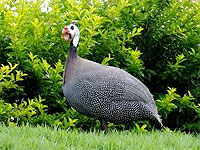|
Vaughan Family Timestream® Maps |
| Home Biography People Places Multimedia: Making It Work On the Water Writings/Presentations |
Tick Eradication Program
From a Discussion on CliffNotes, 2012
Scientists' Cliffs, Port Republic, MD
Re: Tick Eradication Program Proposed - Guinea Hens
By way of testimony, I can confirm that these cute grey neck-bobbers are among the more aggressive of the feathered farm species.
My neighbor in Maine, Annabel, to the delight and entertainment of many of us, kept a flock of these ungainly critters. Annabel was an eccentric hoarder, a retired school teacher who lived alone in her deceased dad's ramshackle place (she never admitted it needed work until the barn fell in, but then she never admitted that fact, either, and stepped around the barn boards that acreted like pick-up-sticks in her yard) where fourth-graders hurried furtively past: she was known by all kids on the schoolbus to be a real witch living in a definitely haunted house. Her dozen or more guinea hens were of the "free range" variety because they lived in the woods behind her chicken coops, not in the coops or a fenced area, and went where they pleased when they pleased. Better named a posse than a gaggle, I think, they would quickly muster for the approach of a car or an eight-year old on foot and swarm the interloper fearlessly from the side of the road, like trained guard geese chasing a fox or mall teenagers assailing a shoe shop for price-reduced Nikes… It was the hen's misplaced arrogance and wild abandon that was most entertaining but occasionally disconcerting as the birds slid into blind spots to peck at the sidewalls.
The Guinea hens were never noisy - no morning rooster calls. No poop to see, either, at least from the road. The birds never ventured more than a few hundred yards from their home roost, it seemed.
So if you needed to start an effective tick eradication program at the Cliffs, you might consider a population density of, say, two dozen birds per acre with a roost situated every 400 or 500 meters along the roads or in the woods of Gates A through E. Likely the birds would also require regular feeding (eek!, if the flock could survive on ticks alone we would have to admit to a bigger tick problem than creepily imaginable!). Being a scientific community, though, perhaps a Tick Committee could be formed which might apply for a summer grant to provide a "before" picture of the infestation for measuring the effectiveness of the eradication program in ensuing years.
As an exit strategy, there is always:
Guinea Fowl with Tarragon-Dill Butter (Parelhoen met Dragon-Dille Boter)
Guinea Hen with Pomegranates Sauce Recipe- Faraona alla Melagrana
